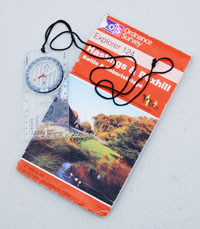The Ghost of Workers Past: Delving into the history hidden in your woodland Part 1

This is the first of a series of short articles in which I hope to de-mystify some aspects of woodland archaeology. To many people, archaeology means ‘excavating holes with little trowels’ and ‘Time Team’. But the first thing I should point out is that digging holes is one of the last things archaeologists do; they have a look at the ‘humps and bumps’ first, and that’s what we’ll be doing.
My intention is to help you, as a woodland owner, find out as much as you can about the history of your bit of woodland: its owners, the uses made of the wood, whether it has always been woodland, what was growing there before the present crop, whether it was part of a larger estate, whether it had tracks running through it, and quite a lot more. It’s surprising what you can learn from the trees, the ground flora and the topography – what’s there in front of you.
I don’t want to put you off doing anything in your wood in case you damage the archaeology. Clearly we don’t want to let a digger driver loose to level off all the banks and fill in the holes, but there’s no reason why we can’t plant on woodbanks, just like anywhere else. After all, it’s because the trees have been there up till now with their roots keeping the soil where it is that we’ve got such a rich archaeological heritage in our woodlands at present.
No special equipment is necessary to undertake a survey, but a fair dollop of your time will have to be committed. But don’t worry – you’ll find it all becomes quite addictive and you won’t notice the passage of time, though your partner may! And it’s not just adults who can get involved, there’s scope for kids to do their bit as well.
I manage a small wood near Heathfield (with lots of archaeology in it) so I hope I will be talking your sort of language. I’m asked by owners to help with the archaeology in their woods, so my experience is becoming fairly varied; my interest in woodland archaeology is quite recent, so I’m learning all the time.
So, where do you start?
It’s either at the local archive centre searching for documents or in the wood itself looking for evidence on the ground. You could start with either one or the other. Professional archaeologists (and I’m not one, though I’m going to be talking quite a bit as though I am!) are keen you start at the record office. I don’t because I think that if you find something there on paper which suggests you should be seeing a feature on the ground, then you’ll go back to the wood and your imagination will do the rest whether it’s there or not. And another reason is that you want to start right now.
I start by looking to see what’s on the ground. And this is quite tricky. What you’ve got to do is work out which bumps and depressions are man made and which are natural. Summer is probably not the best time to be looking because the brambles, bracken and undergrowth generally is doing its best to hide what’s underneath. But if you’ve had the wood for a while you’ll be getting used to the flat bits, or the bumpy bits, even though you don’t know what they may represent. The question of whether they are natural or man made comes with experience, but I’m going to give you some help next time. One rarely finds all the features in the first survey – once your eye is in you’ll re-visit some minor bumps long after you think you’ve finished.
You are going to need a large-scale map printed out on a sheet of A4 paper to do your recording on. You don’t need to be able to find your way round a computer but it can help. The scale is up to you; I use 1:6250. Anything higher than 1:10000 is really too small for recording small features. The map is also going to need grid lines drawn every 100m, so the kilometre square on OS maps should be divided into tenths. To get 1:6250 I take an OS map of 1:25000 and increase the linear size by 4. I scan it and then multiply the width and height measurements by four. Copyright on maps means you are not permitted to copy OS maps less than 50 years old for commercial use, but you are allowed to make a single copy for your own personal use.
I will look at finding, identifying and recording features next.
South East Woodland Archaeology Forum
Reproduced by kind permission of the Small Wood Owners Group
Comments are closed for this post.
Discussion
David,
Thank you for a very interesting series of articles. One feature in our woodland in the Weald which has puzzled us is the occurrence of double, and in places, triple ditches running in parallel. These are not straight and run across as well as down slopes. The wood is recorded on the earliest 16th century maps and from various old documents goes back much further so these will not be field features. We shall be investigating further but wondered if you had any ideas on what these parallel ditches may be.
Yours,
Garth Hudson
The larger the scale of the map, the more accurately you can plot what you’ve found, so 1:2500 is absolutely ideal. In fact, it’s much better to use a map at the scale it was printed, because in the process of enlarging you enlarge any inaccuracies in the printing. lines get thicker, and so on. Some HER (Historic Environment Record) officers prefer to have features plotted on an accurate map to grid references, so if you are getting them recorded on the HER, the more accurate the better.
My emphasis in this series of articles is to use the absolute minimum of specialist gear to keep costs down. In addition not all readers of the article will necessarily own a wood and have a large scale map.
Most woodland owners would have maps already, a copy of their Land Registry title plan which would most likely be at a scale of 1:2,500. This plan may not have a grid but 100 metres at this scale is 4cm so it’s easy to add a grid. Also if owners are contemplating applying for Woodland Management Plans or EWGS from the Forestry Commission then maps would be provided by the FC at a scale of 1:5,000 with a grid. The maps are based on Ordanance Survey County Series or the newer digital Superplans. Would it be correct to assume these maps would be suitable for archaeological surveying?



Garth
I suspect this is one of those features which it will be very difficult to interpret without seeing them in context. Do you know what the underlying geology of your wood is, as this could have a bearing? How long are they and do they follow other features (eg banks)? Do they cross the wood? Where are the ends in relation to (a) the edge of the wood and (b) working areas either inside the wood or beyond the boundary?
My own wood is in the Weald and I would be happy to come and have a look at your ditches. Get in touch via [email protected]
Cheers
David
David Brown
30 April, 2010